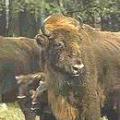 針對歐洲哺乳類動物所做的首次評估中發現,有近六分之一的哺乳類動物正面臨瀕臨絕種的危機,此份評估報告為歐盟執委會提出,世界自然保育聯盟(IUCN)負責執行。研究結果於22日國際生物多樣性日(International Biodiversity Day)當天發表。
針對歐洲哺乳類動物所做的首次評估中發現,有近六分之一的哺乳類動物正面臨瀕臨絕種的危機,此份評估報告為歐盟執委會提出,世界自然保育聯盟(IUCN)負責執行。研究結果於22日國際生物多樣性日(International Biodiversity Day)當天發表。
IUCN的評估報告顯示,歐洲的哺乳類動物有27%正持續減少,33%還無法確認,只有8%證實其數量有增加的趨勢。
IUCN負責人瑪騰烈福(Julia Marton-Lefèvre)表示,「這項評估證實,歐洲哺乳類動物數量的減少已達到了警戒值,但我們仍有力量去扭轉這個趨勢,以歐洲野牛的成功復育為例,就可以很清楚發現這一點。」
負責此項評估作業的坦普(Helen Temple)、同時為IUCN紅皮書( Red List Unit)團隊之成員,她表示「雖然歐洲是世界上最被廣為研究的區域之一,但研究結果與實際行動的結合卻少得可憐,我們對於整個歐陸的哺乳類保育情況缺乏一個全面性的觀點。」
為了彌補這個知識斷層,歐盟委派IUCN對照其紅皮書名單,對於歐陸的哺乳類動物做一個全面性的評估,確認歐洲目前面臨最緊急瀕絕危機的哺乳類動物,並協助確立保育工作的優先順序。
Nearly one in every six species of European mammals is now threatened with extinction, finds the first assessment of all European mammals, requested by the European Commission and carried out by the World Conservation Union, IUCN. The findings were released today to mark International Biodiversity Day.
The IUCN assessment shows that 27 percent of all European mammals have declining populations, and trends for a further 33 percent are unknown. Only eight percent of mammal species were identified as increasing.
IUCN Director-General Julia Marton-Lefèvre said, "This new assessment proves that many European mammals are declining at an alarming rate. However, we still have the power to reverse that trend, as the case of the European bison, which was brought back from extinction, clearly shows."
"Although Europe is one of the best studied regions of the world, little of this knowledge has been brought together and until now, we have had no overall view of the conservation status of mammals across the continent," said Helen Temple of IUCN's Red List Unit, who led the assessment.
To fill that gap, the European Union commissioned the IUCN to assess all mammals of continental Europe against the IUCN Red List criteria in order to identify Europe's most threatened mammals and help set conservation priorities.


